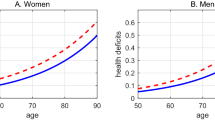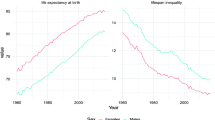Abstract
Human lifespan has increased enormously this century1,2,3. But we remain uncertain about the forces that reduce mortality, and about the cost implications of ageing populations4,5 and their associated social burden. The poor understanding of the factors driving mortality decline2,6,7, and the difficulty of forecasting mortality8,9,10,11 are due in part to the pronounced irregularity of annual to decadal mortality change7,12. Here we examine mortality over five decades in the G7 countries (Canada, France, Germany, Italy, Japan, UK, US). In every country over this period, mortality at each age has declined exponentially at a roughly constant rate. This trend places a constraint on any theory of society-driven mortality decline, and provides a basis for stochastic mortality forecasting. We find that median forecasts of life expectancy are substantially larger than in existing official forecasts. In terms of the costs of ageing, we forecast values of the dependency ratio (that is, the ratio of people over 65 to working people) in 2050 that are between 6% (UK) and 40% (Japan) higher than official forecasts.
This is a preview of subscription content, access via your institution
Access options
Subscribe to this journal
Receive 51 print issues and online access
$199.00 per year
only $3.90 per issue
Buy this article
- Purchase on Springer Link
- Instant access to full article PDF
Prices may be subject to local taxes which are calculated during checkout


Similar content being viewed by others
References
Smith, D. W. Human Longevity. (Oxford Univ. Press, New York, 1993 ).
Preston, S. H. in Forecasting The Health of Elderly Populations (eds Manton, K. G., Singer, B. H. & Suzman, R. M.) 51–77 (Springer, New York, 1991).
Preston, S. H. Mortality Patterns in National Populations, with Special Reference to Recorded Cause of Death. (Academic, New York, 1976).
Lee, R. D. in Demography of Aging (eds Martin, L. G. & Preston, S.H.) 8– 49 (National Academy Press, Washington DC, 1994).
World Bank Policy Research Report Averting the Old Age Crisis: Policies to Protect the Old and Promote Growth (Oxford Univ. Press, Oxford, 1994).
McKeown, T. The Modern Rise of Population (Academic, New York, 1976).
Tuljapurkar, S. & Boe, C. Mortality change and forecasting: How much and how little do we know? N. Am. Actuarial J. 2, 13–47 ( 1998).
Horiuchi, S. & Wilmoth, J. Age patterns of the life-table ageing rate for major causes of death: Aging, disease and mortality in Japan, 1951–1990. J. Gerontol. A 52, B67– B77 (1996).
Wilmoth, J. R. Are mortality projections always more pessimistic when disaggregated by cause of death? Math. Popul. Stud. 5, 293– 319 (1995).
Manton, K. G., Stallard, E. & Tolley, D. H. Limits to human life expectancy. Popul. Dev. Rev. 17, 603–637 ( 1991).
Meslé, F. Classifying causes of death according to an aetiological axis. Popul. Stud. 53, 97–105 (1999).
Wilmoth, J. R. in Health and Mortality among Elderly Populations (eds Caselli, G. & Lopez, A.) 266–287 (Oxford Univ. Press, Oxford, 1996).
Lee, R. D. & Carter, L. Modeling and forecasting the time series of US mortality. J. Am. Stat. Assoc. 87, 659–671 (1992).
von Storch, H. Comment on statistics and physical oceanography. Stat. Sci. 9, 215–221 (1994).
Broomhead, D. & King, G. Extracting qualitative dynamics from experimental data. Physica D 20, 217– 236 (1986).
de León, J. Empirical EDA Models to Fit and Project Time Series of Age Specific Mortality Rates. Technical Report No. 50. (Central Bureau of Statistics, Oslo, 1990).
Himes, C. L., Preston, S. H. & Condran, G. A. A relational model of mortality at older ages in low mortality countries. Popul. Stud. 48, 269–291 (1994).
Lee, R. D. & Skinner, J. in Assessing Knowledge of Retirement Behavior (eds Hanushek, E. A. & Maritato, N. L.) 195– 243 (National Academy Press, Washington DC, 1996).
Wilmoth, J. R. The future of human longevity: a demographer's perspective. Science 280, 395–397 ( 1998).
Bell, W. Comparing and assessing time series methods for forecasting age-specific fertility and mortality rates. J. Official Stat. 13, 279–303 (1997).
Lee, R. D. & Tuljapurkar, S. Stochastic population forecasts for the United States: Beyond high, medium, and low. J. Am. Stat. Assoc. 89, 1175–1189 ( 1994).
Preston, S. H. Evaluation of postwar mortality projections in the United States, Canada, Australia, New Zealand and Japan. World Health Statistics Report 27, 719–745 ( 1974).
Population Projection of Japan: 1996–2050 . Technical Report (National Institute of Population and Social Security Research, Tokyo, 1997).
de Beer, J. & de Jong, A. National population scenarios for countries of the European Economic Area. Maandstatistiek van de Bevolking 44, 7–19 ( 1996).
Goss, S., Wade, A., Bell, F. & Dussault, B. Historical and projected mortality for Mexico, Canada, and the United States. N. Am. Actuarial J. 2, 108–126 (1998).
Canada Pension Plan, Seventeenth Actuarial Report , (Office of the Chief Actuary, Office of the Superintendent of Financial Institutions, Canada, 1998).
Acknowledgements
We thank M. Anderson, R. Lee and K. Wachter for comments. This work was supported by the US National Institute of Aging and the John Simon Guggenheim Foundation (S.T.).
Author information
Authors and Affiliations
Corresponding author
Rights and permissions
About this article
Cite this article
Tuljapurkar, S., Li, N. & Boe, C. A universal pattern of mortality decline in the G7 countries. Nature 405, 789–792 (2000). https://doi.org/10.1038/35015561
Received:
Accepted:
Issue Date:
DOI: https://doi.org/10.1038/35015561
This article is cited by
-
Multi-population mortality modelling and forecasting with divergence bounds
Annals of Operations Research (2024)
-
Bayesian modelling of best-performance healthy life expectancy
Journal of Population Research (2024)
-
Multipopulation mortality analysis: bringing out the unobservable with latent clustering
Quality & Quantity (2023)
-
The relay for human longevity: country-specific contributions to the increase of the best-practice life expectancy
Quality & Quantity (2022)
-
Assessing excess mortality in times of pandemics based on principal component analysis of weekly mortality data—the case of COVID-19
Genus (2021)
Comments
By submitting a comment you agree to abide by our Terms and Community Guidelines. If you find something abusive or that does not comply with our terms or guidelines please flag it as inappropriate.



